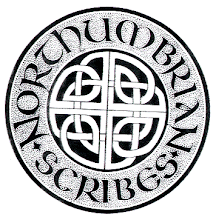 The afternoon activity was with Susan Moor and she showed us how to create Celtic knots using a drawn grid and painting in the elements of the design. She let us use some of the red pigment she was given as part of her recent Time Team filming experience and with it she mixed egg tempera paint. The egg yolk used gives the paint a rich, glossy look and it is smooth to apply. Some tests for paint coverage made during the Time Team filming are shown below.
The afternoon activity was with Susan Moor and she showed us how to create Celtic knots using a drawn grid and painting in the elements of the design. She let us use some of the red pigment she was given as part of her recent Time Team filming experience and with it she mixed egg tempera paint. The egg yolk used gives the paint a rich, glossy look and it is smooth to apply. Some tests for paint coverage made during the Time Team filming are shown below.  After we had all got ourselves knotted over this we then moved on to the highlight of the afternoon; a talk from Professor Richard Gameson on the origins and influences on the creation of the Lindisfarne Gospels. The main questions that Professor Gameson addressed were why these gospels were made, why they look as they do, and what were they for?
After we had all got ourselves knotted over this we then moved on to the highlight of the afternoon; a talk from Professor Richard Gameson on the origins and influences on the creation of the Lindisfarne Gospels. The main questions that Professor Gameson addressed were why these gospels were made, why they look as they do, and what were they for? He explained that the Lindisfarne monastery was an Irish foundation and when the Synod of Whitby of 664 AD decided to sideline the Irish tradition the blow to the power and prestige of the religious establishment there was deep. The Lindisfarne Gospels may have been a response to this.
He explained that the Lindisfarne monastery was an Irish foundation and when the Synod of Whitby of 664 AD decided to sideline the Irish tradition the blow to the power and prestige of the religious establishment there was deep. The Lindisfarne Gospels may have been a response to this.He described how the vibrant design of the Gospels was the result of borrowings and adaptations from some very different sources: the spaces between the words and graphic symbols such as capitals and punctuation were from the Irish Insular tradition; the canon tables were based on Italian designs to which Eadfrith added Celtic knotwork and Germanic ornament; only Greek gospels then had portraits in them so this idea was copied, as were the Greek titles; Irish books had carpet pages so these were used incorporating crosses and other Christian symbols and these pages can be 'read' too. The text integrated Latin, Greek and runic style letterforms with the designs and this harmony of text and ornament points strongly one artist, probably Eadfrith, being the creator. A 10th century colophon states that the book was created by him.
 In combining so many elements the book seemed to make a statement about Irish-Columban traditions in a Roman world. And did it succeed? Professor Gameson said that Alcuin wrote subsequently that nowhere is holier than Lindisfarne, so it seems to have.
In combining so many elements the book seemed to make a statement about Irish-Columban traditions in a Roman world. And did it succeed? Professor Gameson said that Alcuin wrote subsequently that nowhere is holier than Lindisfarne, so it seems to have.Where do Wallace and Gromit fit in? Professor Gameson talked about the travels of Benedict Biscop and Ceolfrith and likened the pair to the plasticine characters - although he didn't say who he thought was which.












